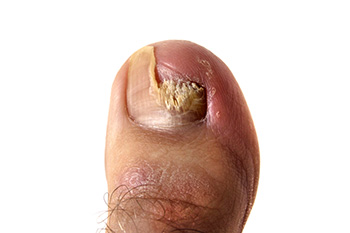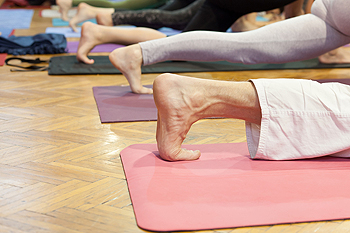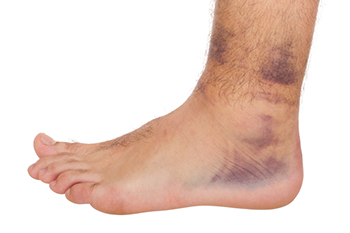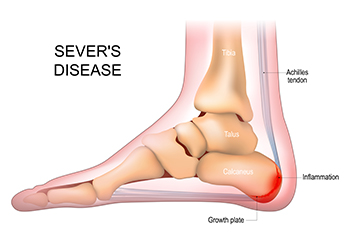Connect With Us
Blog
Items filtered by date: January 2025
When to See a Doctor for a Broken Toenail

A broken toenail can be painful and distressing. It often occurs after stubbing your toe, dropping something heavy on it, or injuring it during physical activities like running or sports. Symptoms of a broken toenail include pain, swelling, and redness surrounding the nail. In some cases, the nail may turn black and blue, indicating bleeding under the nail, or it may even break off completely. The severity of a broken toenail depends on the type of injury. If the nail is cracked but still attached, treatment usually involves cleaning the area and protecting the nail with a bandage. However, in more severe cases, the nail may need to be removed to prevent infection. A podiatrist can assess the damage and provide proper treatment, including draining any pooled blood or addressing signs of infection like increased redness or swelling. If necessary, this foot doctor may offer guidance on proper nail care during the healing process. If you have a broken toenail, it is suggested that you schedule an appointment with a podiatrist.
Ingrown toenails may initially present themselves as a minor discomfort, but they may progress into an infection in the skin without proper treatment. For more information about ingrown toenails, contact Patricia Mcilrath, DPM of Health One Podiatry. Our doctor can provide the care you need to keep you pain-free and on your feet.
Ingrown Toenails
Ingrown toenails are caused when the corner or side of a toenail grows into the soft flesh surrounding it. They often result in redness, swelling, pain, and in some cases, infection. This condition typically affects the big toe and may recur if it is not treated properly.
Causes
- Improper toenail trimming
- Genetics
- Improper shoe fitting
- Injury from pedicures or nail picking
- Abnormal gait
- Poor hygiene
You are more likely to develop an ingrown toenail if you are obese, have diabetes, arthritis, or have any fungal infection in your nails. Additionally, people who have foot or toe deformities are at a higher risk of developing an ingrown toenail.
Symptoms
Some symptoms of ingrown toenails are redness, swelling, and pain. In rare cases, there may be a yellowish drainage coming from the nail.
Treatment
Ignoring an ingrown toenail can have serious complications. Infections of the nail border can progress to a deeper soft-tissue infection, which can then turn into a bone infection. You should always speak with your podiatrist if you suspect you have an ingrown toenail, especially if you have diabetes or poor circulation.
If you have any questions, please feel free to contact our offices located in Reading and Rittenhouse Square, PA . We offer the newest diagnostic and treatment technologies for all your foot care needs.
Do Your Child's Feet Hurt?
Yoga Is Good for Feet

Yoga stretches can be incredibly beneficial for foot health by improving flexibility, strength, and circulation. Poses like downward dog, mountain pose, and toe stretch help to stretch the plantar fascia, Achilles tendon, and foot muscles. This can reduce the tension and prevent conditions like plantar fasciitis, Achilles tendonitis, and arch pain. Engaging in a regular yoga practice can also enhance balance and alignment, which helps address flat feet and overpronation. Gentle stretches improve joint mobility, reducing stiffness caused by arthritis or prolonged standing. Additionally, yoga’s focus on mindful movement encourages better weight distribution and posture, relieving stress on the feet and ankles. However, while yoga can alleviate discomfort and prevent minor issues, persistent pain or structural concerns require professional evaluation. If you are experiencing ongoing foot or ankle problems, consult a podiatrist for a proper diagnosis and personalized treatment plan.
Stretching the feet is a great way to prevent injuries. If you have any concerns with your feet consult with Patricia Mcilrath, DPM from Health One Podiatry. Our doctor will assess your condition and provide you with quality foot and ankle treatment.
Stretching the Feet
Being the backbone of the body, the feet carry your entire weight and can easily become overexerted, causing cramps and pain. As with any body part, stretching your feet can serve many benefits. From increasing flexibility to even providing some pain relief, be sure to give your feet a stretch from time to time. This is especially important for athletes or anyone performing aerobic exercises, but anyone experiencing foot pain or is on their feet constantly should also engage in this practice.
Great ways to stretch your feet:
- Crossing one leg over the others and carefully pull your toes back. Do 10-20 repetitions and repeat the process for each foot
- Face a wall with your arms out and hands flat against the wall. Step back with one foot and keep it flat on the floor while moving the other leg forward. Lean towards the wall until you feel a stretch. Hold for 30 seconds and perform 10 repetitions for each foot
- Be sure not to overextend or push your limbs too hard or you could risk pulling or straining your muscle
Individuals who tend to their feet by regular stretching every day should be able to minimize foot pain and prevent new problems from arising.
If you have any questions please contact our offices located in Reading and Rittenhouse Square, PA . We offer the newest diagnostic and treatment technologies for all your foot and ankle needs.
Take Care of That Ankle Sprain

Ankle sprains occur when the ligaments in the ankle stretch or tear, often causing immediate pain, swelling, bruising, and difficulty moving the joint. They typically happen when the ankle twists or turns awkwardly, such as during sports or a misstep while walking. It is important to note that up to 70 percent of people experience lasting symptoms after an ankle sprain, including instability and weakness. This increases the risk of recurrent sprains, especially if not properly managed. Proper treatment, including targeted exercises and, in some cases, bracing or custom orthotics, can help restore strength and prevent further injury. A podiatrist can assess the severity of the sprain, ensure proper healing, and provide a personalized rehabilitation plan. If you have sprained your ankle, it is suggested that you make an appointment with a podiatrist to reduce the risk of ongoing issues.
Although ankle sprains are common, they aren’t always minor injuries. If you need your ankle injury looked at, contact Patricia Mcilrath, DPM from Health One Podiatry. Our doctor can provide the care you need to keep you pain-free and on your feet.
How Does an Ankle Sprain Occur?
Ankle sprains are the result of a tear in the ligaments within the ankle. These injuries may happen when you make a rapid shifting movement while your foot is planted. A less common way to sprain your ankle is when your ankle rolls inward while your foot turns outward.
What Are the Symptoms?
- Pain at the sight of the tear
- Bruising/Swelling
- Ankle area is tender to touch
- In severe cases, may hear/feel something tear
- Skin discoloration
Preventing a Sprain
- Wearing appropriate shoes for the occasion
- Stretching before exercises and sports
- Knowing your limits
Treatment of a Sprain
In many cases, the RICE method (Rest, Ice, Compression, and Elevate) is used to treat ankle sprains. However, you should see a podiatrist to see which treatment option would work best with your injury. In severe cases, surgery may be required.
It is important to ask your doctor about rehab options after you receive treatment for your injury. Stretching, strength training, and balance exercises may help the ankle heal while also preventing further injury.
If you have any questions, please feel free to contact our offices located in Reading and Rittenhouse Square, PA . We offer the newest diagnostic and treatment technologies for all your foot care needs.
Why Does My Childs Heel Hurt?

Sever's disease is a common condition that causes heel pain in growing children, particularly those active in sports. The growth plate in the heel bone, known as the calcaneus, becomes irritated due to repetitive stress. This condition typically affects children between the ages of eight and fourteen during rapid growth. The primary symptom of Sever's disease is pain in the heel that can worsen with activity and improve with rest. Swelling or tenderness may also be present surrounding the heel area. Risk factors of Sever's disease include participating in high-impact sports like soccer and basketball and having tight calf muscles or flat feet. Rest, stretching, and supportive footwear may help alleviate symptoms. If your child has heel pain, it is suggested that you consult a podiatrist for proper treatment.
Sever's disease often occurs in children and teens. If your child is experiencing foot or ankle pain, see Patricia Mcilrath, DPM from Health One Podiatry. Our doctor can treat your child’s foot and ankle needs.
Sever’s Disease
Sever’s disease is also known as calcaneal apophysitis, which is a medical condition that causes heel pain I none or both feet. The disease is known to affect children between the ages of 8 and 14.
Sever’s disease occurs when part of the child’s heel known as the growth plate (calcaneal epiphysis) is attached to the Achilles tendon. This area can suffer injury when the muscles and tendons of the growing foot do not keep pace with bone growth. Therefore, the constant pain which one experiences at the back of the heel will make the child unable to put any weight on the heel. The child is then forced to walk on their toes.
Symptoms
Acute pain – Pain associated with Sever’s disease is usually felt in the heel when the child engages in physical activity such as walking, jumping and or running.
Highly active – Children who are very active are among the most susceptible in experiencing Sever’s disease, because of the stress and tension placed on their feet.
If you have any questions, please feel free to contact our offices located in Reading and Rittenhouse Square, PA . We offer the newest diagnostic and treatment technologies for all your foot care needs.

